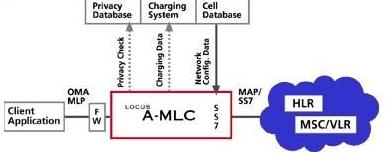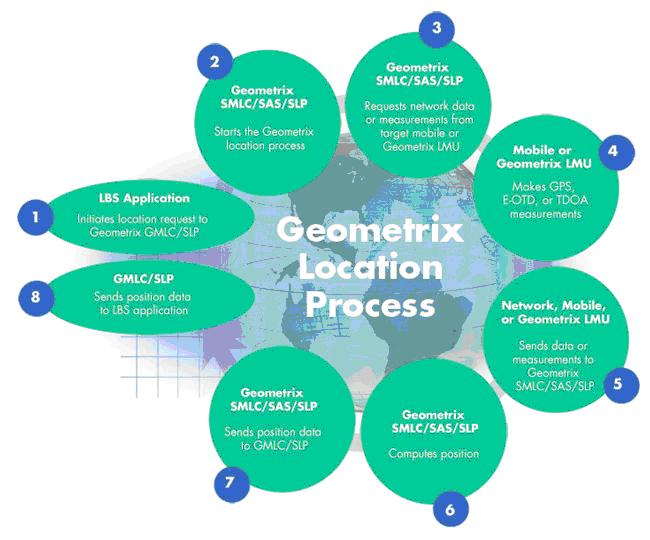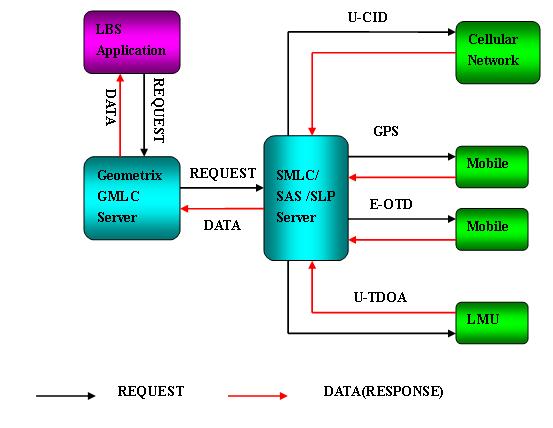Some companies and their products which use MLP:
Locus Portal : A-MLC[9] - Locus A-MLC is a fully featured mobile positioning system. The solution includes a high accuracy GSM network positioning capability for building and running Mobile Location Services. Locus A-MLC solution architecture is compliant with OMA (Open Mobile Alliance) specifications. A Locus A-MLC system environment is described below:
(source : http://www.locusportal.com/products/amlc/prod_amlc_sysenv.html)
A-MLC is a self-contained network element, physically implemented in a 19" rack, and connects to IP- and SS7 networks as described here. The Open Mobile Alliance (OMA) Mobile Location Protocol is supported in A-MLC. Client Applications (Mobile Location Services) connect to A-MLC using standard Open Mobile Alliance (OMA) MLP protocol. The connections are secured and access to the internal network is protected by a firewall. Connecting clients are authenticated before granting access to positioning information.
CommeScope(Andrew): Geometrix MLC mobile location system[10] - Its unparalleled advantage is that it is capable of applying the full range of mobile locating tachonologies to best match the particulars of a given location-enhanced service/application or set of application. Geometrix MLC supports handset-based, network-based, and hybrid locating technologies on a common platform. Operators can utilize the following techniques individually or in combination: Cell Identity (CID) Assisted-GPS (A-GPS) Enhanced Cell Identity (E-CID) Matrix Uplink Time Difference of Arrival (U-TDOA) Angle of Arrival (AOA)
(source http://www.commscope.com/andrew/eng/product/geometrix/capabilities/index.html)
The steps of the Geometrix Syetem Operation
- MSC or LBS application launches location request to Geometrix GMLC server. The GMLC server receives request, determines appropriate positioning technology, including selection between SUPL (Secure User Plane Location) and CoPL (Control Plane Location).
- Geometrix SMLC (Serving Mobile Location Center)/SAS (Stand-alone SMLC)/SLP (SUPL Location Platform) server receives request from GMLC server and begins location process.
- SMLC/SAS/SLP server queries network (for E-CID), target mobile (for A-GPS, Matrix), or Andrew LMU (for U-TDOA) for measurements or other data
- Mobile captures GPS or E-OTD measurements, or Andrew LMU (for U-TDOA only) and measures target mobile signal
- Mobile (for A-GPS, Matrix) or Andrew LMU (U-TDOA) sends measurements to Geometrix SMLC/SAS/SLP server.
- Geometrix SMLC/SAS/SLP server receives measurements and computes position.
- Geometrix SMLC/SAS/SLP server sends position data to GMLC server (through BSC and MSC).
- Geometrix GMLC server sends position data to LBS application.
Ericsson - Mobile Positioning System(MPS)[11] - It is Ericsson's positioning platform for Location Based Services. MPS supports both the SS7-based control plane and the IP-based Secure User Plane Location (SUPL) architectures.
MPS supports the standardized Mobile Location Protocol (MLP).
It supports the cell-based positioning methods Cell Global Identity with Timing Advance (CGI/TA), Enhanced CGI (E-CGI), Cell ID and Round Trip Time (RTT- similar to TA) for WCDMA and Any Time Interrogation (ATI).
It supports Spatial Triggers, a function that notifies applications automatically when a mobile phone enters or leaves a certain pre-defined location, or when two mobile phones approach each other.


